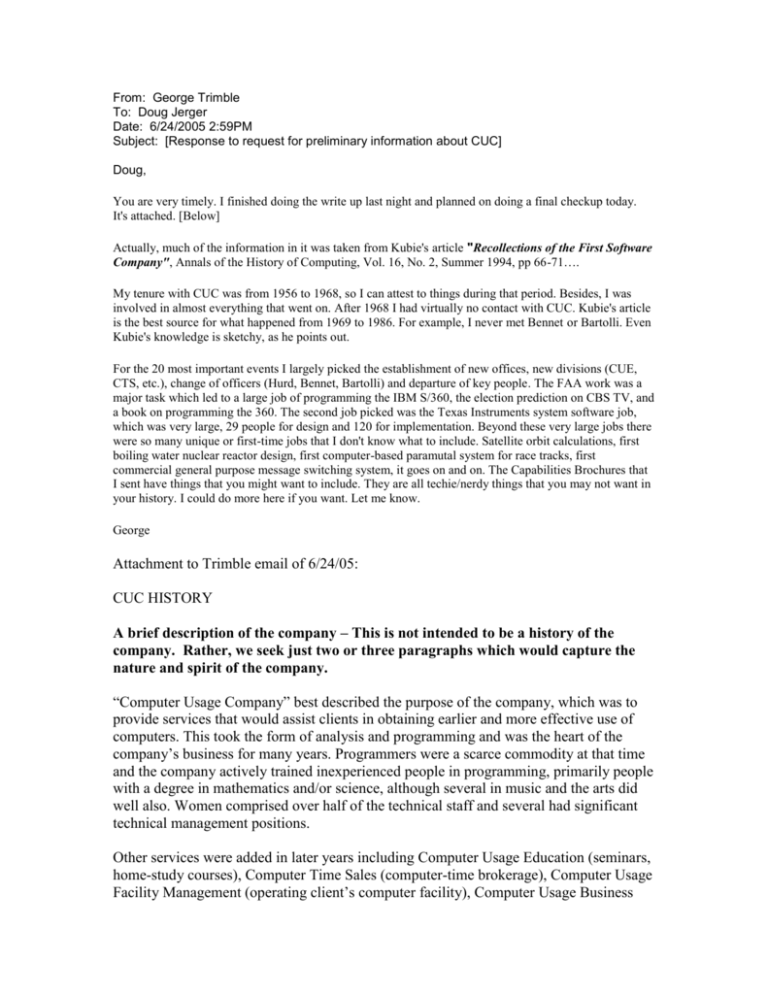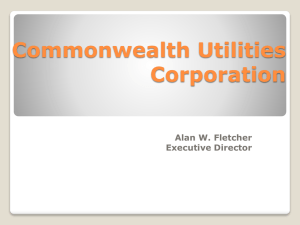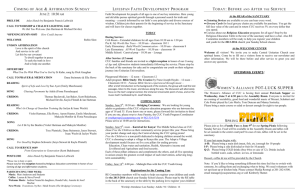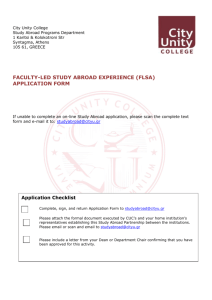From: George Trimble - the Information Technology Corporate
advertisement

From: George Trimble To: Doug Jerger Date: 6/24/2005 2:59PM Subject: [Response to request for preliminary information about CUC] Doug, You are very timely. I finished doing the write up last night and planned on doing a final checkup today. It's attached. [Below] Actually, much of the information in it was taken from Kubie's article "Recollections of the First Software Company", Annals of the History of Computing, Vol. 16, No. 2, Summer 1994, pp 66-71…. My tenure with CUC was from 1956 to 1968, so I can attest to things during that period. Besides, I was involved in almost everything that went on. After 1968 I had virtually no contact with CUC. Kubie's article is the best source for what happened from 1969 to 1986. For example, I never met Bennet or Bartolli. Even Kubie's knowledge is sketchy, as he points out. For the 20 most important events I largely picked the establishment of new offices, new divisions (CUE, CTS, etc.), change of officers (Hurd, Bennet, Bartolli) and departure of key people. The FAA work was a major task which led to a large job of programming the IBM S/360, the election prediction on CBS TV, and a book on programming the 360. The second job picked was the Texas Instruments system software job, which was very large, 29 people for design and 120 for implementation. Beyond these very large jobs there were so many unique or first-time jobs that I don't know what to include. Satellite orbit calculations, first boiling water nuclear reactor design, first computer-based paramutal system for race tracks, first commercial general purpose message switching system, it goes on and on. The Capabilities Brochures that I sent have things that you might want to include. They are all techie/nerdy things that you may not want in your history. I could do more here if you want. Let me know. George Attachment to Trimble email of 6/24/05: CUC HISTORY A brief description of the company – This is not intended to be a history of the company. Rather, we seek just two or three paragraphs which would capture the nature and spirit of the company. “Computer Usage Company” best described the purpose of the company, which was to provide services that would assist clients in obtaining earlier and more effective use of computers. This took the form of analysis and programming and was the heart of the company’s business for many years. Programmers were a scarce commodity at that time and the company actively trained inexperienced people in programming, primarily people with a degree in mathematics and/or science, although several in music and the arts did well also. Women comprised over half of the technical staff and several had significant technical management positions. Other services were added in later years including Computer Usage Education (seminars, home-study courses), Computer Time Sales (computer-time brokerage), Computer Usage Facility Management (operating client’s computer facility), Computer Usage Business Services (payroll, accounting services). These latter two services, although initiated by Kubie, were later considered by him to be significant factors in the decline of the income of the company after 1968-69. A lack of strong emphasis on the analysis and programming end of the business, which was the heart of the business until that time, was also a major factor in the decline that led to it’s bankruptcy in 1986. A very positive aspect of CUC is the attitude of it’s employees toward their tenure with the company. There was a great camaraderie among them that existed even between the different offices. Many felt that CUC was the greatest place to work that they had ever experienced, either before or after working at CUC. The challenges were, in many cases, beyond their past experience, and they were given the freedom to meet the challenge. They felt that they were given responsibility, learned a tremendous amount, and grew professionally. A “reunion” of CUC employees was held in New York in 1995, and these feelings well widely expressed by those attending. A listing of the 20 most important events in the life of the company – We would appreciate having them related to a date and to have three or four sentences describing each event. March 28, 1955: Formally created the company as a sole proprietorship: John Sheldon doing business as Computer Usage Company (CUC). April, 1955: Hired Louise B, Greene as secretary/bookkeeper and hired four programmers. October 3, 1955: Incorporated in Delaware as Computer Usage Company, Inc. Elmer C. Kubie – President and Treasurer John W. Sheldon – Vice President Louise B. Greene – Secretary and Controller February 1956: Hired George R. Trimble, Jr., Corporate Technical Director During the 3 ½ years that Kubie and Trimble worked together in the IBM Endicott Labs they had frequently discussed the possibility of forming such an independent software company. Trimble stayed on with IBM until work on the IBM 650 Magnetic Drum Calculator was finished and then he joined Kubie and Sheldon at CUC. Summer 1959: Washington, D. C. Office established, Walter Nelson, Manager. As a byproduct of work done by Trimble for the Navy in Washington, D. C. to establish the information requirements for the Chief of Naval Operations (CNO), which was the basis for building the Naval OPCON Centers, additional Federal Government work justified establishing a Washington office. April 1960: IPO netted $186,681. After an 82 for 1 stock split, sales of 47,000 shares of stock to the public netted $186,681 for the company. 1960-62: Awarded a major contract by the FAA for work on the Air Traffic Control System. A field office was established at the FAA National Aviation Facilities Experimental Center (NAFEC) in Pomona, NJ, headed by George Trimble. The job was to determine the requirements for a computer-based Air Traffic Control System. It involved analyzing the functions performed by the air traffic controllers and establishing the software requirements for the development of such a system. This resulted in specifications for a JOVIAL language compiler, and supporting utility routines (assembler, loaders, debugging system, etc.) 1960: Computer Time Sales (CTS) Division formed. Serving clients who had machine time to sell and clients who wanted to buy machine time, CTS acted as a computer-time broker and provided scheduling, operating, and administrative services to the seller. Emanuel Chafets directed this division. Spring 1961: Los Angeles Office established, George Vosatka, Manager Work done for North American Aviation on it’s Minute Man Reliability project provided a basis for establishing a Los Angeles office. Summer 1962: Dr. Cuthbert C. Hurd elected Chairman of he Board. Dr. Hurd had established the Applied Science Department at IBM, which became a Division, and he was very influential in getting IBM into the computer business. He had strong contacts in the computer industry as well. He left IBM to become Chairman of the Board of CUC. 1963: Programming the IBM System/360 for IBM. As a result of the specifications developed at the FAA NAFEC, FAA contracted with IBM for 9020 computer systems (actually tri-plex IBM System/360, Model 50s) for the ATC application. IBM then contracted with CUC to program the System/360, including the JOVIAL compiler and all of the supporting software (but not the application software.) Ascher Opler directed this effort. Early 1964: IBM contracted with CUC to use the software being developed for the System/360 to develop a program to keep track of the election results, 1964 being a presidential year. This system was used by CBS TV to report these results on election evening. Based on this experience CUC staff members wrote a book “Programming the IBM System/360” which was published by John Wiley and Sons in 1966. 1964: John Sheldon resigned. A reduction in the amount of heavy scientific application development led John Sheldon, a founder of CUC, to retire and raise shell-fish in New England. 1965: Computer Usage Education (CUE) formed. Having recruited many people into the field and trained them, CUC formed an educational division to capitalize on this experience. A Home-Study course was developed and Seminars on a variety of computer related subjects were given. Ascher Opler directed this activity. 1965: Computer Usage Development Company (CUDC) formed. The analysis and programming part of the business was set off as a separate division. Summer 1966: Hired Carl H. Reynolds as President of CUDC. Carl H. Reynolds was an experienced program development manager at IBM and was heavily involved in the IBM OS/360 software development. He was hired to manage the CUDC division. 1966: Computer Usage Facility Management (CUFM) formed. Computer Usage Business Services (CUBS) formed. 1967: Texas Instruments (TI) contracted with CUC for major system software. TI was developing the Advanced Scientific Computer (ASC), a super-computer, and needed a full set of system software for it. They contracted with CUC to develop the software, including an operating system, a FORTRAN compiler, assembly program, graphics support, database management, and all of the appropriate utility programs that go with such a system. A Dallas office was established and George Trimble was the Systems Engineer directing the project. July 1968: Elmer C. Kubie retired (health reasons). Charles Benton, Jr. hired to replace him. September 1968: George R. Trimble, Jr. resigned from Computer Usage Company. December 1968: Computer Usage Business Services (CUBS) discontinued. 1970: Benton retired for health reasons and Victor Bartoletti became president. September 1986: Ceased Operation A listing of the names of founders, officers, or of other essential key people of the company – We would also appreciate any contact information which you may have. We would also appreciate their names even if they are no longer with us. Elmer C. Kubie – Founder – President & Treasurer – Deceased John W. Sheldon – Founder – Vice President – Director, Scientific Applications George R. Trimble, Jr. – Corporate Technical Director Dr. Cuthbert C. Hurd – Chairman of the Board (1962-1974) – Deceased Louise B. Greene – Secretary & Controller Dr. Liston Tatum – Vice President – Sales/Marketing Walter B. Nelson – Vice President, Manager, Washington Office Mr. Robert H. Glaser – Manager, New York Office Mr. Emanuel Chafets – Manager, Computer Time Sales Division Mr. Anthony J. Penta – Director, Commercial Applications – Deceased Mr. Ascher Opler – Director, Systems Programming – Deceased A listing of the names of 20 of the people most significant for the company – Again, we would appreciate their names even if they may no longer be with us. Elmer C. Kubie – Founder – President & Treasurer – Deceased John W. Sheldon – Founder – Vice President – Director, Scientific Applications George R. Trimble, Jr. – Corporate Technical Director Dr. Cuthbert C. Hurd – Chairman of the Board (1962-1974) – Deceased Dr. Liston Tatum – Vice President – Sales/Marketing Mr. Anthony J. Penta – Director, Commercial Applications – Deceased Mr. Ascher Opler – Director, Systems Programming – Deceased Mr. Charles Sheffield – Senior Scientific Analyst – Deceased Mr. Dean Brown – Senior Scientific Analyst ------[content edited for relevancy] [contact information deleted to protect the privacy of correspondents]


![John McDonald, Director, Claremont Colleges Library [PPT]](http://s2.studylib.net/store/data/005395875_1-1935e1d320e49e3ca4701d9a87404d36-300x300.png)


